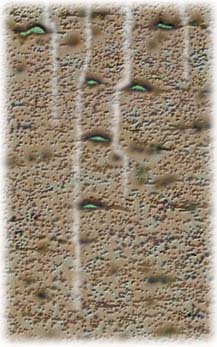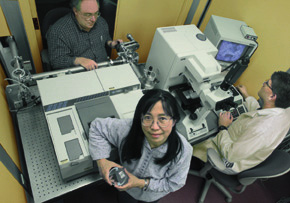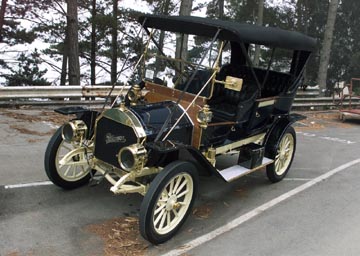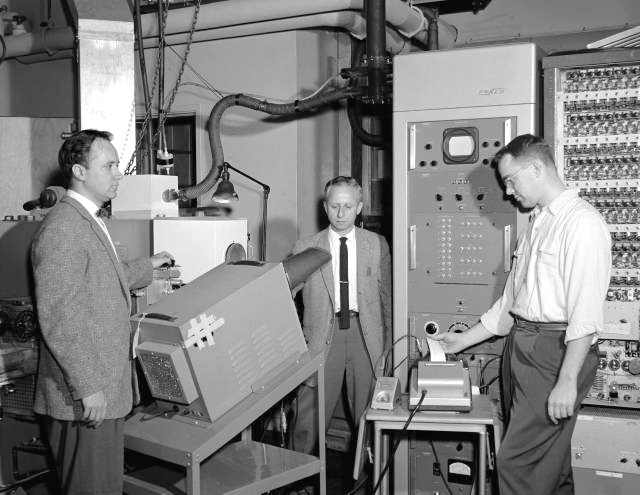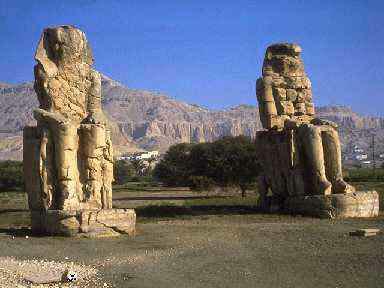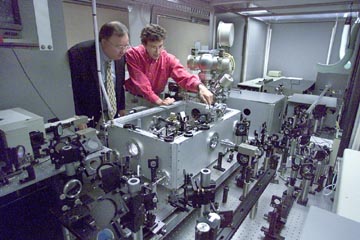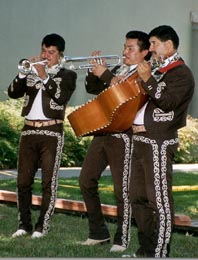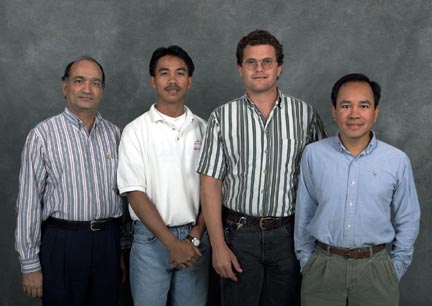
| Safe Cleanup of Waste Sites Microbes in Basalt Thrive on Toxic Waste |
Modern techniques shed light on ancient mysteries Nuclear Physics Meets Archaeology |
Microbes in Basalt Thrive on Toxic Waste
By Paul Preuss
Discovery could lead to environmentally safe cleanup of waste sites
Seventy-five meters beneath the surface of a site in Idaho where high-level radioactive waste has been stored for more than 40 years, microorganisms living in the pores and crevices of dry basaltic rock are able to reduce a toxic form of chromium to a much less toxic form -- and they do so faster in the presence of volatile organic wastes.
Berkeley Lab's Hoi-Ying Holman and her colleagues made the discovery by examining basalt core samples from beneath the Radioactive Waste Management Complex at the Department of Energy's Idaho National Engineering and Environmental Laboratory. For the first time, using infrared spectromicroscopy at the Advanced Light Source (ALS), the researchers followed the reduction of toxic metals by populations of live organisms on minerals.
Moreover, says Holman, a chemist and engineer with the Earth Sciences Division and the Center for Environmental Biotechnology (CEB), "We have shown that organic vapor may accelerate the transformation of mobile, toxic chromium pollutants into less mobile, less toxic, stable compounds. This should help in the design and implementation of new, environmentally benign remediation techniques for cleaning up mixed waste sites."
CEB's Dale Perry, Jennie Hunter-Cevera and Tamas Torok, along with Michael Martin, Wayne McKinney and Geraldine Lamble at the ALS, were among those who contributed to the discovery.
Pick your poison
The Idaho site is polluted with mixtures of hexavalent chromium (that's chromium stripped of six electrons) and other inorganic ions, radionuclides, petroleum hydrocarbons, and volatile organic compounds. Hexavalent chromium is carcinogenic, mutagenic, and highly toxic to organisms because it occurs in soluble chromates that readily cross cell membranes.
Once inside a living cell these ions are reduced first to pentavalent chro-mium and then to trivalent chromium, which disrupts DNA replication. Outside the cell, however, trivalent chromium is much less toxic, because it is insoluble and cannot cross cell membranes.
|
A biological mechanism was one hypothesis. The dry Columbia River basalts are limited in organic carbon and other nutrients, Holman says, but dense clusters of microorganisms live in the pores and fractures of the rock.
"When water infiltrates from rain or melting snow, a burst of nutrients reaches them through fissures in the rock, and they bloom like flowers in the desert," she says, which suggests that microbes played a role in the metal reduction. It was uncertain which microorganisms could be involved, however, and what metabolic processes were important.
An alternate, chemical-mechanism hypothesis proposed that metal oxides such as iron oxides in basalt could help catalyze reductions with no help from living microbes.
A bacterial champ
To determine which mechanism was at work, Holman and her colleagues obtained basalt core samples from dry rock deep beneath the site. From these, microbiologist Tamas Torok of the Life Sciences Division isolated and purified 85 strains of microorganisms.
Many were tolerant of hexavalent chromium and able to reduce it -- especially in the presence of toluene, another of the site's contaminants and a common product of leaking fuel tanks. But many of the organisms encountered bottlenecks that slowed the reaction process.
Finally, one strain of bacteria --Arthrobacter oxydans -- emerged as champion.
But since A. oxydans tends to concentrate in areas rich in magnetite (an iron-oxide compound common in basalt), the researchers had to eliminate the possibility that the magnetite itself was responsible for the reduction.
They performed a series of tests to see if reactions would proceed under realistic environmental conditions: in an aerobic atmosphere, at room temperature, and in the dark.
For five days, working at the ALS's infrared beamline 1.4.3, the researchers observed the steps involved in the reduction process and the precise location of reduced chromium.
Surprising light
"The infrared is the end of the spectrum not usually associated with synchrotrons," says Holman, "but for us it's perfect. ... We could resolve the spectrum in time, to follow the different steps of the reduction, and also in space, to see exactly where the reactions were happening."
On the samples with no living bacteria, no changes were evident; even on samples with living A. oxydans, in the absence of toluene chromium reduction was weak. But where A. oxydans had been exposed to toluene, infrared spectromicroscopy showed that hexavalent chromium was reduced and toluene was degraded -- right where the bacteria were concentrated.
To find out if the same thing happen in nature -- that is, at the waste site -- "we now needed to study natural communities in the basalt," says Holman.
With the help of Andre Mei, a machinist in the Technical Services Department, she devised a unique diamond saw that could cut thin slices from fresh basalt cores -- slowly, at cool temperatures (the only pressure is the core's own counterbalanced weight against the cutting wire), and under aseptic conditions.
Over a period of four months the slices of native rock, with their resident communities of microbes still in place, were exposed to solutions of hexavalent chromium and toluene vapor. At first, infrared spectromicroscopy showed no evidence of reduction, and it appeared that many of the organisms were dying. But after four months, chromium-tolerant and chromium-reducing natural microorganisms were seen to be thriving -- in association with trivalent chromium.
Says Holman, "As far as we know, this is the first time that infrared synchrotron studies have been used to follow the steps in the transformation of toxic chromium on mineral surfaces."
More information on the work of Holman and her colleagues can be found online at www-als.lbl.gov/als/als_news/news_archive/vol.133_080499.html#1.
Their report is posted at http://infrared.als.lbl.gov/pubs/HYHbacteria98.pdf.
|
Lab Traffic in the Olde Days?
|
Nuclear Physics Meets Archaeology
By Allan Chen
Modern techniques shed light on ancient mysteries
When relying on potsherds instead of people as their sources, archaeologists can learn a lot about ancient cultures. Layers in which fragments are bur-ied suggest the age of the culture; changes in pottery design or decoration give hints about a culture's evolution and contact with others; and a fragment's composition may indicate where a population lived and how widely it traveled or traded.
In culturally complex areas, however, where various settlements were manufacturing and trading wares of similar composition, the standard methods of archaeology -- excavating and comparing decorative styles and materials -- are not always sufficient to unambiguously determine whether an artifact was actually made where it was found.
This is where new methods of materials analysis known as instrumental neutron activation analysis (INAA) and x-ray fluorescence (XRF) come in. The work of Berkeley Lab's Frank Asaro, Robert D. Giauque and their colleagues has shown that these methods can help solve archaeological problems, as demonstrated in a recent collaboration with archeaologist David Adan-Bayewitz of Bar-Ilan University in Israel, in which XRF was applied to pottery from more than 20 sites in northern Israel. Asaro formally retired from the Lab in 1991, although he says he continues to work full-time "and often longer, just for the fun of it."
Determining the origin of ancient pottery -- or provenance -- can help archaeologists better understand the relationships and influences between peoples. Correlating pottery fragments found in excavations with the ancient workshops in which they were made helps illuminate the trade and cultural contacts among ancient settlements.
Determining Provenance
By measuring the abundance of trace and major elements in a pottery fragment, and comparing these with those in the soil and artifacts at known pottery workshops, researchers can often determine provenance. "INAA has been the method of choice for measuring elemental abundances be cause of its great precision and reliability, but it has some disadvantages," says Asaro. "One is that INAA requires a nuclear reactor, and XRF does not. Another has to do with more complicated sample preparation and analytical procedures. INAA results can often take several months to complete, even for a small number of samples."
Asaro and Giauque, who work in the Environmental Energy Technologies Division, collaborated with Adan-Bayewitz to demonstrate that a new methodology of x-ray fluorescence (XRF) can be used to determine pottery provenance with comparable measurement precision to INAA. XRF does not require a nuclear facility, relying instead on a conventional silicon x-ray spectrometer with an x-ray tube -- widely-available lab equipment. A single investigator can complete XRF results in as little as a few hours.
|
The research team analyzed pottery samples from ancient sites in the Galilee and neighboring areas in northern Israel using both the standard INAA method and XRF. The ages of the artifacts ranged from the first century B.C. to the fourth century A.D. The researchers demonstrated that both methods were effective in measuring provenance. Moreover, Asaro says, "XRF was also able to distinguish better than INAA between two sets of pottery from nearby sites that were very similar in composition.
"We showed that XRF holds promise as a cheaper, faster method than NAA for determining archaeological provenance while being equally effective," he concluded. A paper reporting their results was published in Archaeometry earlier this year.
"To the best of our knowledge," says Adan-Bayewitz, "the kind of extensive intra-regional provenance study we are engaged in has not yet been conducted elsewhere ... In most provenance studies, the questions asked might be whether the pottery is local or imported, or whether the pottery was made in one country or another -- for example, in Iron Age Cyprus (1200-586 B.C.) or ancient Israel. In our work, our interest is in site-specific provenance: whether the pottery was made at site x or at site y, which might be as little as two miles away. This definition of the provenance problem aims at a better understanding of mobility and contacts within a region. But in order to achieve this, the analytical techniques employed must be capable of distinguishing between pottery of similar composition made at nearby sites."
New Testament connection
One reason for the interest in the Galilee area, and why this work is important, is that the region was home to several major cultures. The most important texts of Rabbinic Judaism were compiled there during the Roman period. The disciples of Jesus are said to have lived there, as did several major pagan communities. "The relationships between the peoples of this region in the Roman period continue to be of intense scholarly interest," says Adan-Bayewitz. "An example of how our work has contributed to these questions is the problem of rural-urban conflict in Galilee. It had been widely accepted among New Testament scholars that the `Jesus movement' was comprised of village Jews who were alienated from the cities, with their populations of rabbis and hellenized Jews. Support for this hypothesis was found in the New Testament in the absence of any reference to the two Galilean cities, Sepphoris or Tiberias, despite their proximity to villages discussed extensively in the Gospels. For example, Nazareth is only about 6 km from Sepphoris.
"Our work has demonstrated that about three-fourths of the common kitchen ware used at Sepphoris in the Roman period came from the Galilean village of Kefar Hananya, about 27 km away. These data show that there was continual contact between village and city. It is common pottery -- by far the most prevalent artifact to survive from antiquity -- analyzed with high precision chemical techniques, that provides quantifiable and statistically meaningful data, opening a window on local contact and relationships in antiquity."
Tools of physics for archaeology
The road to techniques of analysis used in this and many other archaeological studies began in the 1950s at Berkeley Lab. Early in his career, as one of Isadore Perlman's first Ph.D. students (Perlman was head of the Chemistry Division and associate director of Berkeley Lab), Frank Asaro studied the excited states of the nuclei of heavy elements by measuring the states of their alpha particle emissions, and later, gamma ray emissions. During the 1950s and early 1960s, Asaro, Perlman and their colleagues did groundbreaking work in this field, which contributed crucial evidence for a now accepted model of the nucleus called the unified model.
In the mid-1960s, Perlman became interested in archaeology. He and Asaro realized that they could use the gamma ray emissions of trace radioactive elements in a pottery sample to measure very accurately the abundances of elements in the sample, pinning the sample's origin to a unique location where the materials were quarried or dug. After bombardment by neutrons, the elements in the sample would emit gamma rays of various discreet energies, revealing unique signatures.
By comparing the gamma rays of the unknown sample with known reference samples -- measurements that they had been making for more than a decade -- they determined the concentrations of elements in the sample, and with it, the origin of the pottery. The paper they published in 1969 on their work became a landmark, and the most heavily cited in its field.
"How good was Perlman at choosing new fields?" asks Asaro. "I thought I would take three months off to do this. I made that decision in 1967, and I'm still doing this work 32 years later."
|
From Palestinian Bichrome to Colossi of Memnon and California artifacts
In the years that followed, Asaro, Perlman, and other colleagues conducted a number of studies which solved some archaeologically significant problems. With Michal Artzy, Perlman and Asaro demonstrated in 1967 that an innovative Middle Bronze Age style of pottery known as Palestinian bichrome, long considered to have been manufactured in Palestine, was actually manufactured in Cyprus and exported to Palestine.
Bichrome was first discovered by the great English archaeologist Sir Flinders Petrie and later found throughout the Middle East.
Turning their attention to Egypt in 1973, Asaro and his colleagues began studying the Colossi of Memnon, two 50-foot hewn-quartzite statues located near Luxor. These guardians of Pharoah Amenhotep III were built before 1,200 B.C. In 27 B.C., an earthquake felled half of the north statue, and the damage was not repaired until 200 A.D. by order of Roman emperor Septimus Severus. Archaeologists thought that the quartzite had come from a quarry 100 miles away near Aswan. Using neutron activation analysis, Asaro and his co-workers showed that the original rock for the statues came from quarries in Cairo, 420 miles away, and that the Romans subsequently used stone from the nearer Aswan quarry to repair the statue.
And in 1977, Asaro and Helen Michel demonstrated that the Plate of Brass, a much-celebrated artifact said to have been left on the California coast by Sir Francis Drake in 1579, was not authentic. Neutron activation analysis showed that zinc content was too high and the impurity levels too low for sixteenth century English manufacturing techniques. The brass in the plate, which was found under a rock in 1936, was most likely manufactured no earlier than the first half of the nineteenth century.
Dinosaur extinction collaboration
The work that is perhaps best known to the general public was Asaro and Michel's collaboration with Luis and Walter Alvarez in measuring the abundance of iridium in a layer of rock found throughout the world that was formed at the end of the Cretaceous era, 65 million years ago. Begun by the father-and-son Alvarez team of Berkeley Lab and UC Berkeley, the work led the group to propose that the dinosaur extinctions were caused by Earth's collision with an asteroid.
About half of the measurements of iridium abundances from samples of the Cretaceous-Tertiary boundary layer throughout the world were done by Asaro and Michel using an instrument now called the Alvarez Iridium Coincidence Spectrometer.
The work continues
Asaro, Giauque and Adan-Bayewitz continue their collaboration and are refined the precision of the techniques.
Says Adan-Bayewitz, "Our work on the development and application of high-precision XRF will make this high-precision analytical method available to other researchers, enabling them to investigate such problems of mobility and trade in other regions and periods.
Spotlight on Lab Safety: Walkthrough in Bldg. 71
|
Washington Report
Richardson Responds to NIF Cost Overrun Reports
R
eports of cost overruns and schedule delays in the construction of the $1.1 billion National Ignition Facility (NIF) at the Lawrence Livermore National Laboratory brought a swift response from Energy Secretary Bill Richardson. He announced a series of measures aimed at getting NIF "back on track," including withholding $2 million of the University of California's management performance fee.NIF is a laser facility designed to simulate the behavior of nuclear weapons without physical testing. It is supposed to open in 2003 and serve as a cornerstone of DOE's Stockpile Stewardship Program.
"I am deeply disturbed to learn of projected cost overruns and scheduling delays associated with NIF," the Secretary said in a public statement. "I also am gravely disappointed with the University of California and the Department of Energy's Lawrence Livermore National Laboratory for its `late reporting' to the Energy Department of these significant problems."
Richardson's actions also include establishing an independent expert panel to analyze NIF's technical program; shifting costs within DOE's Defense Programs division and LLNL budget funding lines so "the U.S. taxpayer does not foot additional bills;" improving DOE oversight of NIF management by including it on the department's Project Management Watch List; implementing an LLNL management review to determine whether the lab misled DOE about NIF's status; and requiring LLNL to hire a private contractor to assemble NIF's major components rather than doing the job inhouse.
"The problems with NIF are not technological -- the underlying science of the NIF remains sound," Richardson said. "These are project management issues, and we will get ahead of these problems and turn them around with aggressive and tighter management action from this department."
In their separate responses to Richardson's announcements, both LLNL Director Bruce Tartar and UC President Richard Atkinson expressed agreement with the Energy Secretary's stance.
Said Tartar, "We share Secretary Richardson's concerns related to NIF and we will work closely with DOE to implement his directives. We will also work closely with UC on this issue."
Furthermore, Tartar said that NIF had been made an institutional program reporting directly to his office and that George Miller, LLNL's associate director for national security, would oversee its day-to-day operations. He also appointed Ed Moses as the new project manager for NIF, replacing Jeffrey Paisner. Miller and Robert Kuckuck, LLNL's deputy director of operations, have also been directed to conduct a thorough review to investigate management actions related to NIF.
"The Lab is committed to all actions necessary to ensure the timely success of NIF for the DOE's Stockpile Stewardship Program," Tarter said.
In his response, UC President Atkinson said, "The University of California will cooperate fully with DOE reviews of the cost and schedule of NIF. ... We agree with the Secretary of Energy that any managerial issues must be dealt with so that it can be brought to a successful completion."
FESAC Recommends Huge Boost for Fusion Energy
DOE's Fusion Energy Sciences Advisory Committee (FESAC) has re-commended that DOE spend at least $300 million annually on its Office of Fusion Energy Sciences (OFES), calling the spending boost necessary in order to maximize research and development of magnetic and inertial fusion energy technology. In a draft of a report commissioned by Science Director Martha Krebs, FESAC said that DOE should spend $250 million on magnetic fusion and $50 million on inertial fusion energy R&D. Berkeley Lab is one of the national leaders in inertial fusion energy research.
DOE received $222.6 million in FY99 for OFES and has sought the same amount for FY 2000. Of that figure, $212.7 million was set aside for magnetic research and the remainder was designated for inertial activities. While the Senate energy and water appropriations bill matches DOE's request, the House version would provide $250 million for OFES.
The FESAC draft represents the latest effort by DOE to determine the future direction of fusion energy research. A recent Secretary of Energy Advisory Board task force encouraged greater collaboration between OFES and the Defense Programs division to speed up the fusion energy effort. The FESAC report considered the R&D implications of funding OFES at $300 million, $260 million and $222 million, and agreed that the highest figure was the most appropriate.
A copy of the draft, "Report of the FESAC Panel on Priorities and Balance," is available on the Internet at http://fire.pppl.gov.-- Lynn Yarris
Campisi Wins Award for Aging Research
T
he Glenn Foundation for Medical Research has announced that Judy Campisi of the Life Sciences Division is the recipient of the 1999 Glenn Foundation Award for her contributions to the field of aging biology.The foundation is devoted to the extension of healthy, productive life through research on the mechanisms of biological aging.
"I was extremely surprised and honored," Campisi said. "Knowing some of the past recipients and the standards to which the selection committee aspires, I was also duly humbled. The award shall impel me to think and work even harder. We need to understand why we age, so that rational interventions can be developed."
Said Mina Bissell, director of the Life Sciences Division, "Judy Campisi is one of this country's foremost basic science researchers in the aging field. The Glenn committee has selected wisely and the Life Sciences Division is fortunate to have her here."The Glenn Award carries a cash prize and the honor of presenting the Glenn Award plenary biological sciences lecture at the Gerontological Society of America's annual meeting on Nov. 22 in San Francisco. -- David Gilbert
New Dean of Chemistry College
Clayton H. Heathcock, a prominent organic chemist and a member of the National Academy of Sciences, was named dean of the College of Chemistry at UC Berkeley last month. A professor and former chair of the campus's chemistry department, Heathcock succeeds Alexis T. Bell, who is now on sabbatical and will return to teaching and research next year.
Heathcock has been associated with UC Berkeley since 1964, and served as vice chairman of the Department of Chemistry from 1972 through 1977 and as its chairman from 1986 through 1989.
He is known for his work in the total synthesis of natural products and the development of new synthetic methodology, of major interest to the pharmaceutical industry as well as to the international academic community.
Heathcock is completing 10 years as editor-in-chief of the Journal of Organic Chemistry, and also serves on the Board of Directors of Organic Syntheses.
JGI Expands Sequencing Operation
L
ast month the Joint Genome Institute (JGI) announced the purchase of 60 additonal MegaBACE 1000 DNA sequencers from Amersham Pharmacia Biotech, increasing the number of these machines in operation at JGI to 86. JGI is a consortium of Berkeley Lab, Livermore and Los Alamos national laboratories."Since our initial order was installed in June, we have been extremely impressed with the results and performance of MegaBACE," said Trever Hawkins, director of sequencing at JGI. "The increase of productivity that MegaBACE can provide will be critical in allowing the Joint Genome Institute to meet its very accelerated sequencing goals for the Human Genome Project."
The Human Genome Project is a global effort to decode the three billion letters that comprise the human genome. The resulting blueprint of life could enhance scientific understanding of diseases and lead to advanced methods of prevention and treatment.
The new machines can sequence DNA up to three times faster than methods previously available. Launched last year by Molecular Dynamics (a division of Americium Pharmacy Biotech), the MegaBACE 1000 was the first multiple-capillary sequencer to reach the sequencing market.
Established in 1996, the JGI is one of the five largest publicly-funded human genome centers in the world. -- Monica Friedlander
Berkeley Lab Currents
Published twice a month by the Public Information Department for the employees and retirees of Ernest Orlando Lawrence Berkeley National Laboratory. Ron Kolb, PID department head.
EDITOR: Monica Friedlander,
(510) 495-2248, msfriedlander@ lbl.gov
STAFF
WRITERS: Paul Preuss, 486-6249; Lynn Yarris, 486-5375
CONTRIBUTING WRITERS:
Jon Bashor, X5849; Allan Chen, X4210, Jeffery Kahn, X4019
FLEA MARKET /
CALENDAR: Vikki Davis, 486-5771, fleamarket@ lbl.gov /
currents_calendar@lbl.gov
Public Information Department, Berkeley Lab, MS 65A, One Cyclotron Road,
Berkeley CA 94720
Tel: (510) 486-5771 * Fax (510) 486-6641
Berkeley Lab is managed by the University of California for the U.S. Department of Energy.
NERSC Update
New Computers Offer Powerful Resources to Lab Researchers
In late August, NERSC officially accepted an array of three SGI/Cray SV1 supercomputers after a month of testing. The new computers are on average three times faster than the Cray J90se machines they replace. According to SGI/Cray, NERSC was one of the first centers to receive certified production models of the SV1.
"These supercomputers will aid our scientific users in their work on some of the most important problems facing science today," said NERSC director Horst Simon. "For example, in the area of climate research, more accurate and detailed models of the earth's climate are giving us a better understanding of the effects of human activity on our global environment."
The computers will be used by DOE-sponsored climate researchers to gauge the effect of greenhouse gases and sulfate aerosols on the atmosphere. The NERSC staff recently ported the Climate System Model (CSM) to the Cray SVI. Developed by the National Center for Atmospheric Research (NCAR), CSM analyzes conditions in the atmosphere, ocean, land surface and sea ice to create a comprehensive model of climate change.
The SV1 is Cray's newest computer, and is described as the company's first scalable vector supercomputer, combining powerful processors with the "scalability" features necessary to link large numbers of processors together.
Stephen Jardin, the principal investigator at the Princeton Plasma Physics Laboratory, has been a long-time user of NERSC supercomputers and is presently chair of NERSC's Program Advisory Committee. He and others in his field have been eager to use the SV1 since its procurement was announced. "Many of our most complex design and simulation codes employ algorithms that are particularly well-suited to the SV1's parallel vector architecture," said Jardin. "We expect to be able to make very effective use of these machines immediately."
Leading the acceptance testing were Jackie Scoggins and Tina Declerck of NERSC's Computational Systems Group; Majdi Baddourah and Dave Turner of the User Services Group; and SGI/Cray personnel Bob Thurman, Terence Brewer, Bill Contento and Mike Stewart. Clayton Bagwell of NERSC's Computer Operations Network Support Group was the official timetracker for the evaluation. -- Jon Bashor
Lab Observes Hispanic Heritage Month
In recognition of National Hispanic Heritage Month, Berkeley Lab is sponsoring
a number of the events throughout the month of September, ranging from folk
dance and Mexican delicacies to a speakers' forum. The activities were
organized by the Work Force Diversity Office with assistance from the Latino
and Native American Association (LANA). They include:
Special performance: Los Cenzontales
Thursday, Sept. 16, noon
|
The group Los Cenzontales will play on the cafeteria stage/lawn. The performance will include folkloric song and dance.
Speakers' Forum
Sept. 24, noon, Bldg. 50 auditorium
Pedro Noguera, a professor of social and cultural studies at UC Berkeley's Graduate School of Education, and Marsha Murrington, deputy executive director of the Spanish Speaking Unity Council, will be the guest speakers. Noguera will talk about "California's Latino majority and the implications for everyone else." Murrington's lecture is entitled "Giving Back to the Community."
Mexican Cuisine at the cafeteria
Thursdays in September, Ed Almendarez and Alex Frantz will serve authentic Mexican cuisine at "Passports" in the cafeteria every Thursday of the month.
National Hispanic Heritage Month celebrates and recognizes the contributions and achievements of Hispanic Americans. Started in 1968 as National Hispanic Heritage Week, the period was expanded in 1988 to National Hispanic Heritage Month. Among others, the event recognizes Sept. 16, Mexico's independence day.
The Office of Work Force Diversity has developed an annual Multicultural Events Resource Guide -- available online at http://www.lbl.gov/Workplace/WFDO/MRG/ -- which seeks to foster understanding of customs, beliefs and contributions of the diverse cultures and traditions that are found among Lab employees.
For more information about these events or to join the Latino and Native American Association, contact LANA co-chairs Rosa Rodriguez-Flores (X4766, RROdriguez-Flores@lbl.gov ) or Claudia Quezada (X4232, Cquezada@lbl.gov.)
Further information is also available on the web at http://www.lbl.gov/Workplace/HumanResources/EAA/html/cultural.html.
DOE Honors Lab Group for Energy Saving Effort
Berkeley Lab is the recipient of a 1999 DOE Small Group Energy Efficiency Award for its "Lighting Retrofit and Fan Controls" energy saving project. Members of the group recognized by this honor are Mahesh Gupta, chief of the Electrical Section in Facilities, energy engineer and technical coordinator Tai Voong, electrician Steve Cooper, and lighting technicians Arnel Jugarap and Ron Catungal. The project was initiated by the In-House Energy Management section in Facilities.
By retrofitting lighting and fan systems throughout the Laboratory, the project saved Berkeley Lab an estimated $43,483 (or 52.8 percent) in energy costs. Moreover, the reduction in power consumption will also cut down on pollution by an estimated 3,896 tons over the life of the project, according to the group's report.
"I was surprised to hear about the award," said Mahesh Gupta. "This work was part of our job. But I feel we made a contribution to cost and energy savings for the Lab, so it's a step in the right direction."
Improvements included installing occupancy sensors in hallways and offices; replacing old light fixtures and lamps with more efficient ones and adjusting their layout to eliminate excess fixtures while providing adequate light levels; and replacing incandescent track lighting fixtures with compact fluorescent ones. A total of 2,360 fixtures were affected by these retrofits.
The occupancy and photo cell sensors determine whether an area is occupied or when daylight provides sufficient lighting and then turn the lights on or off accordingly. Sensors were also installed to control supply and exhaust fans in places such as bathrooms and common areas.
The project was completed in two phases to expedite the project and minimize discomfort to employees, Gupta said. The first phase, started in June 1997, included replacement of the lamps during regularly scheduled maintenance activities. The second phase, implemented between January and July of 1998, included activities such as fixtures replacement and rewiring of the exhaust air fans.
The DOE awards will be presented on Oct. 27 during a ceremony in Washington, DC. -- Monica Friedlander
|
Bulletin Board
Softball Club Season Results
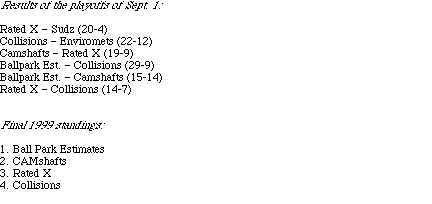
Courier Services
The Facilities Department is providing the Lab with rush courier service, with pick-up and delivery both on- and off-site. Transportation can deliver up to 2,000 pounds anywhere in the Bay Area or in central or northern California. Onsite materials will be delivered within one hour. For offsite service, a driver is available during normal business hours for same-day pick up and delivery. To request a pick-up, call Peggy Patterson at X5404.Courier service (two-hour, four-hour, same day, and rush service) is also available from IDS Courier, which operates 24 hours a day and provides pick-up and delivery anywhere in the Bay Area and in portions of northern and central California. For information call Linda Wright at 548-3263.
Mountain Lion Info on the Web
A few mountain lions are known to share living quarters with us in the East Bay Hills, and they have occasionally been reported to roam onsite. In order to keep Lab employees up to date about mountain lion sightings on the Hill, the EH&S Division has posted a web page at http://www.lbl.gov/ehs/security/sightings.htm. In addition to information about recent sightings, the website includes general safety guidelines, such as:
- Do not hike alone.
- Keep children close to you.
- Should you encounter a lion, do not run from it. Instead, face the animal and make eye contact.
- Do not crouch down or bend over.
- Do all you can to appear larger.
- Fight back if attacked.
To report moutain lion sightings, call the Security Office at X5472. Questions may be directed to Don Bell at X6016 or DWBell@ lbl.gov.
Activities Group Still Accepting Nominations for Advisory Panel
Nominations are still being accepted for two openings on the Employee Activities Association Advisory Panel. These three-year positions for a recreational and a cultural group representative are open to all Lab employees.To nominate someone, contact activities coordinator Kathy Gray by e-mail at kjgray@lbl.gov. Make sure to indicate the position you are interested in and include a brief statement with information about yourself and why you are interested in serving on the panel. Labwide elections will be held later this month.
For more information on the Employee Activities Associaation election see the EAA web page at http://www.lbl.gov/Workplace/HumanResources/EAA/. More than a dozen laser vendors will gather in Perseverance Hall on Tuesday, Sept. 14 to demonstrate their equipment. All Lab employees are welcome to attend. Refreshments will be provided.
A meeting of the Bay Area Laser Safety Officers will also be conducted during the fair at 2:00 p.m. in the lower cafeteria.
For more information contact Ken Barat at X7658.
Lab Booth at Sunday's Solano Stroll
For the first time Berkeley Lab will have a booth at the annual Solano Stroll as a means to attract potential employees and conduct community outreach.The annual community event, stretching over a mile-long section of Solano Avenue that will be closed to traffic, is organized by the cities of Berkeley and Albany and draws tens of thousands of area residents.
The Stroll begins at 10 a.m. and features a parade, performers, exhibits of vendors and community organizations, foods, crafts, music and dance. The Lab's booth will be on the north side of the street between San Carlos and Carmel Avenues.
New Employee Orientation Session
The New Employee Orientation session for this month will be held on Tuesday, Sept. 14, starting at 9:00 a.m. in the Bldg. 50 auditorium. The session starts with the required Environment, Health and Safety training (EH&S 10) and is followed by orientation to Berkeley Lab.Currents Online
The full text and color photographs of each edition of Currents are published online at http://www.lbl.gov/Publications/Currents/. You may find a link to Currents on the Lab's home page under the heading "Publications."The site allows users to do searches of past articles going back to 1994.
Williams has been driving and refurbishing cars such as this 1909 model for
much of his life. Although he usually drives an Acura for his commute from
Pinole, last week he drove the Paterson to the Lab for a test run before taking
it out on the road for a longer trip, after having installed an electric
starter in it for the first time. "People stare, but I'm used to it," he says.
"I've been around these cars all my life, so it's no big deal."
Williams's fondness for classic antique cars continues a long family tradition.
His parents and grandparents built and drove these cars for two generations.
Williams himself bought a 1913 Model T Ford right out of high school. But the
1909 Paterson -- his grandfather's acquisition -- holds a special place in his
heart. "I wouldn't sell it. It has a lot of sentimental value for me." Photo by
Roy Kaltschmidt
The Berkeley Lab Calendar is published biweekly here on the World Wide Web and in Currents
by the Public Information Department. Employees can list a meeting, class, or event in the
Calendar by using this submission form.
The deadline for submissions is 5 p.m. on Monday in the week that Currents is published.
In addition to the events listed below, Berkeley Lab's Washington, D.C.
Projects office is hosting a Science
and Technology Seminars series. Scientific Conferences
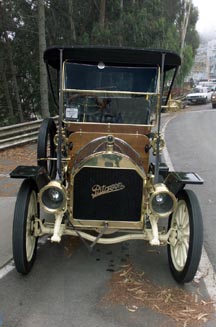
Not Your Ordinary Commute
Decades before the cyclotron -- let alone Berkeley Lab -- was even conceived,
this Paterson Model 30 was making its debut on American roads. Now almost a
century later, Robert "Danny" Williams, who works in Maintenance in Bldg. 77,
drew a few oohs and ahhs from onlookers while driving his prized possession on
the Hill. Calendar of Events
General Interest
MON, SEPT.13
DANCE CLASSFour-week series starts12:00 - 1:00, Bldg. 51 ground floor
MARTIAL ARTS CLASS
Classes are held every Monday and Wednesday from
5:00 to 6:15 p.m. on the ground floor of Bldg. 51.
TUES., SEPT. 14
NEW EMPLOYEE ORIENTATION9:00 a.m., Bldg. 50 auditorium
THURS., SEPT. 16
SHOEMOBILE7:30 - 3:30, cafeteria parking lot
HISPANIC HERITAGE MONTH SPECIAL PERFORMANCE
Los Cenzontales perform
at noon on the cafeteria lawn.
MON., SEPT., 20
DANCE CLASS12:00 - 1:00., Bldg. 51 ground floor
TUES., SEPT. 21
LIFE SCIENCES DISTINGUISHED LECTURE WITH ROBERT TJIAN4:00 p.m., Bldg. 66 auditorium
FRI., SEPT. 24
HISPANIC HERITAGE MONTH SPEAKERS FORUMNoon, Bldg. 50 auditoriumPedro Noguera of UC Berkeley and Marsha Murrington of the Spanish Speaking Unity Council
Items for the calendars may be sent via e-mail to currents_calendar@ lbl.gov, faxed to X6641 or mailed to Bldg. 65B. The deadline for the Jan. 15 issue is 5 p.m. Monday, Jan. 11.
Seminars & Lectures
FRI., SEPT. 10
CENTER FOR BEAM PHYSICS SEMINAR"The LCLS Project at SLAC" will be presented by Max Cornacchia of SLAC/SSRL.
10:30 a.m., Bldg. 71 conference room
MON., SEPT. 13
PHYSICS COLLOQUIUM"Big World of Small Neutrinos" will be presented by Hitoshi Murayama.
4:30 p.m. 1 LeConte Hall, UC Berkeley
THURS. SEPT. 16
MATERIALS SCIENCES DIVISION SEMINAR"Catalysis from First Principles" will be presented by Jens Norskov of Technical University, Denmark.
1:30 p.m., Bldg 66 auditorium
THURS., SEPT. 16
ASTRONOMY COLLOQUIUM"Seeing Light Through the Dark: Infrared Extinction and the Nature of Dark Clouds" will be presented by Charles Lada.
4:30 p.m., 2 LeConte Hall, UC Berkeley
TUES., SEPT. 21
PHYSICAL BIOSCIENCES SPECIAL LECTURE"The Biochemistry of Eukaryotic Transcription in Animal Cells: Tearing Apart a Complex Macromolecular Machine" will be presented by Robert Tjian of Howard Hughes Medical Institute and UC Berkeley.
4:00 p.m., Bldg. 66 auditorium
THURS., SEPT. 23
ASTRONOMY COLLOQUIUM"The Early Evolution of Mars from Mars Global Surveyor" will be presented by Maria Zuber.
4:30 p.m., 2 LeConte Hall, UC Berkeley
FRI., SEPT. 24
PHYSICAL BIOSCIENCES"DNA Repair Genes and Telomere Function" will be presented by Edwin Goodwin of Los Alamos National Laboratory.
2:00 p.m., Bldg. 84-318
FRI., SEPT. 24
CENTER FOR BEAM PHYSICS"Status of SPEAR-3 Design" will be presented by Bob Hettel of SLAC/SSRL.
10:30 a.m., Bldg. 71 conf. room
AIM Computer Classes - September

Classes are held in Bldg. 51L. For more information on AIM training, class description and registration procedure, look up the class website at http://www.lbl.gov/Workplace/EDT/computers/PC_Classes.html or contact Heather Pinto at X4181.
Note: All inhouse courses at this time are taught on PCs with Windows 95. The 97 series programs are used by the newest version of Microsoft Office for Windows 95. Series 6.x programs for the Mac are nearly identical to the Windows 95 versions. The material covered in these courses will be applicable for users of a Mac 6.x series or an older Mac or PC version.
Lab Firefighters Help State's Emergency Response Effort
On Thursday, Aug. 26, Berkeley Lab sent a firefighting engine company to help put out fires in Butte County in support of the Govenor's declared emergency response to the fires raging in various part of the state.
The Lab contribution to this effort consisted of one rig and three firefighters -- Captain Charles Palmer, Leslie Lockhart and Steven Sugar -- who lent their expertise at the state fairgrounds near Chico.
Flea Market
Autos / Supplies
`83 BMW 320i, 5 spd, sunroof, 75 mi on new engine, great cond, runs great, moving to Tahoe, $1500, Peter X4157`83 HONDA Accord, 135K mi, 5 spd, 4 dr, AC, runs great, $1,000/ b.o, Andreas X5453, 845-4672
`86 TOYOTA Tercel Hatchbck, 2 dr, white, 4 spd, 140K mi, ac, am/fm, one owner, runs well, $900, Curt, X7419
`87 HONDA Civic Hatchback Si, 160K mi, runs good, new tires, Yakima racks avail, $1,450, Steve, X6619, 845-6511
`87 NISSAN Sentra Sedan, 132K mi, very good cond, ac, radio/ cass, $1,500, avail 9/20, Xenophon, 601-6480 (eve)
`89 DODGE Caravan LE, 7 pass, 3.0L V6, auto, pwr steer/brake/ lock/wndw/drvr seat, ac, cruise, tilt, tint, roof rack, am/fm/cass, red/burgundy, exc cond in/out, flexible config interior, new front tires/align/alternator, well maint, very comfy, clean, 119K mi, $4,000/b.o., Drew, X5789, 840-1909 (pgr)
`89 HONDA CIVIC, blue, 97K mi, 4 spd, good cond, ac, am/fm/ cass, $3,600/b.o., Dorin, x7779, 704-8723
`89 FORD Bronco 4x4, full-sized wgn, 1 owner, all receipts avail, recent smog cert, tune-up, new tires/brakes, 5 spd/OD, pwr steer/brake/wndw/lock, ac, am/ fm/cass, runs fine, smooth/quiet, $5,000, Thomas, X8617, 430-1736 (eve)
`89 FORD Bronco II 2WD, 171K, exc cond, maint records, new trans/brakes/radiator/fuel pump/tires, auto/OD, pwr steer/brakes/wndw/lock, ac, cruise, am/fm/CD, ski rack, $5,500, Oliver, X5861, 981-0235
`89 TOYOTA Celica ST, 107K mi, white, 2 dr, AC, am/fm/cas, very clean, $2500. Glenn, X4779, 792-1946
90 FORD Taurus, stn wgn, 3L V6, cruise, pwr lock, air bag, new tires, new pwr steer, suspension, spark-plugs, runs very well, $4,000/b.o., Sylvain, X7030 or 658-3271
`90 MAZDA 323, 1.6L, 4 cyl, 71K mi, timing belt/CV boots/ brakes changed, interior in good cond, $1,700/b.o., Isabelle, 653-8154
`91 NISSAN Sentra XE, 88K mi, 2 dr, 5 spd, ac, pwr steer/brake, cruise, exc cond, all records, very reliable, $4,250/b.o., Mike, X2231, 832-6227
`92 CHRYSLER LeBaron Landau,V6 3.0 Liter, only 72 K mi, 4 dr, automatic, ac, air bag, pwr steer/windows/locks/seat, cruise, am/fm/cass, great cond, avail in Oct (date neg), $4995, Erik X6958, 486-1487
EIBACH SPORTLINE SPRINGS, used, for `92-'96 HondaPrelude, only 6-mo-old, $100, Tony, X4261, 919-9446
Housing
BERKELEY, studio apt, Durant/ Telegraph, 1 blk from campus, nicely/fully furnished, wooden flr, avail for 1 month, Sept 17 -Oct 13, $600, gas and electr included, Paolo, X4739.ELMWOOD, share elegant 11 rm house w/ 2 men, 1 woman, non-smoking professionals, $600/mo +dep, shared exp, $745 for mstr bdrm w/ frplc and huge closet, piano, yellow Labrador, laundry, sauna, hardwd flrs, exc neighborhood, woman pref, Tony, 841-4480
KENSINGTON, room avail in cottage in back w/ bth+shwr, no kitchen, share main house, household is semi-coop w/ mix of grad students + working people (2 males/2 females, ages 26-32), sunny kitchen, hot tub, washer/dryer, dishwshr, fruit trees, nice view, bus stop in front, about 1 mi to Wildcat Canyon trail, $465 + cleaners ($20/mo/ person) + util, Christine, 524-2668
MONTCLAIR, 2 rooms in 3 bdrm/2.5 bth house, garage, frplc, 3 decks, backyard, washer/dryer, storage rm, canyon view, 15 min to Lab/UC, lots of space, hardwd flrs, no pets, $580/mo + dep, Ken, X4527, 338-0231
NORTH OAKLAND, 1 bdrm, large dinning rm and fully equiped kitchen, washer/dryer, small yard, water/garbage/cable pd by owner, very quiet, nice area, Golden Gate Ave, $1,500/ mo, Sylvain, X7030 or 658-3271
PIEDMONT house, 2+ bdrms, 2 bth, hardwd flrs, dishwshr, garage, yard, exc schools, gardener, non-smoker, $1,800/mo, Kaz or Gloria, 834-6170
SAN LEANDRO condo for sale or rent, 2 bdrm/1.5 bth, 2 story, washer/dryer in unit, frplc, 3 large walk-in closets, fully equipped kitchen, new carpet, close to downtown shopping, no pets on rental, close to hwys 880, 580 and BART, 15 miles to Lab, $1000/mo+utils and security deposit, or sell for 135K, avail Oct. 1, Ken, X6343, (707) 643-4065
Miscellaneous
49er's TICKETS, Washngtn Redskins 12/26, sec 6/lower res, row 2/seats 18 &19, $150 pair, cash only, Sheryl, X5126COMPUTER, 4.3 GB E-IDE, 64 Mo SDRAM, 2 USB ports + 1 IrDA port, K56 internal modem, CD X 24 + CDRW, Office `97, Corel Draw 8, Photopaint 8, Corel Dream, Photoshop 5, IBM viavoice, more, free Internet access), $1,500/bo, Sylvain, X7030, 658.3271
ELECTRIC CIRCULAR SAW, Porter-Cable 7.25," left handed, model 843K, w/ case and manuals, hardly used, includes 2 carbide blades, 1 new plywood/veneer blade, $100, Ian X5377, 652-0410
BIKES, Murray Ultra Terrain, 18 gears, women's, 26", light green, men's, 26", blue, both 1-yr-old, $50 ea or $90 both, Christoph, X7550
COUCH, leather, burgundy L-shaped, was $3000+, 8'-10' long/ 6' wide, good cond, Tessie, 653-9518MOVING SALE: everything less than 2-yrs-old: futon (full) $180; matress pad (full); $12, dark green kilt (queen), $35; pin shelves, $40; metal shelves, $15, wood bookcase, $20; computer desk, $90; microwave, $40; vacuum, $40; electric citrus juicer, plates (23), pans, hand mixer, coffee maker, vegetable steamer, cordless phone, more, Sylvain X7030, 658.3271
MOVING SALE, 24 gear bike, metallic gray, exc cond, first owner, 7-mos-old, owner's manual and helmet included, $80 ($120 new), Giovani, X7260, 841-2066
MOVING SALE, queen bed + frame, used less than 1 yr, avail 9/20, $300; 2 seat sofabed, $200; furniture, dining set, comforter, glasses, cordless phone, iron, 90+ articles, Xenophon, 601-6480 (eve)
MOVING SALE, 13" Samsung TV, $50; futon, queen, $300/b.o.; quilted bedspreads $20; feather bed king, $70; miror, $15; vaccum $25; lamps, iron table, halogen lamp, blender, mixer, plates/bowls/saucer (4 ea), pillows, sheets, phone, answ mach, more, Isabelle, 653-8154
MOVING SALE, 2-piece furniture set, 1 and 2-cushion couches, very good cond, $100; wooden coffee table, 1.5'x5', $50; queen futon w/ wooden frame, $100; white desk, 2'x4', $40; black metal filing cabinets (2), 2 drwrs ea, $30 pair; wood unfinished bookcase, $10, Brenda, X6067
MYST GAME for Mac, CD, unopened, $15/b.o., Jon, X5974
PRINTER, Epson Stylus Color 440, includes drivers (PC), manual, cable; separate black and color cartridges, as new, $70; Uli, X5265, 559-8794
OPTIMUS SPEAKER SYSTEM, integrated amplifier, 15W subwoofer, two 5W satellites, different connectors to audio sources (computer, walkman, etc), AC 120V 60Hz, as new, $40, Uli, X5265, 559-8794
REFRIGERATOR, Kenmore, exc cond, glass shelves, top level freezer, $250, John, X6573
SOFABED, $50, you haul, Mark, X6581
Wanted
HOUSESITTER, Oakland near Lake Merritt, feed 3 cats, water garden, 9/15-10/15, Ginny, X7413HOUSING for two visiting researchers (couple), arrive 9/22 from Sweden for at least 6 mo, 1 bdrm apt or share house, furn, Berkeley, El Cerrito or Albany (hills), Anders, ante.hellstrom@ telia.com
JOG-STROLLER, suitable for 3-yr-old, collapsible model preferred, Alan X4740
Vacation
TAHOE KEYS, South Lake Tahoe house, 3 bdrm, 2.5 bth, fenced yd, quiet area, close to attractions, private deck, great views of water/mountains, $150/night (2 night min), Bob (925) 376-2211Lost & Found
FOUND: Sony Li Battery #NP-F530, Sept 1 after LBNL softball game, Kleeburger Field, Apryl, X4465, or David X6937
Note: For other lost and found items call X4855.
Flea Market Ad Policy
Ads are accepted only from LBNL employees, retirees, and on-site DOE personnel. Only items of your own personal property may be offered for sale.
Submissions must include name, affiliation, extension, and home telephone number.
Ads must be submitted in writing--via e-mail (fleamarket@lbl.gov), fax (X6641), or delivered/ mailed to Bldg. 65B. No ads will be taken by phone.
Ads will run one issue only unless resubmitted in writing. They will be repeated only as space permits.
The deadline for the Sept. 24 issue is 5 p.m. Friday, Sept. 17.
